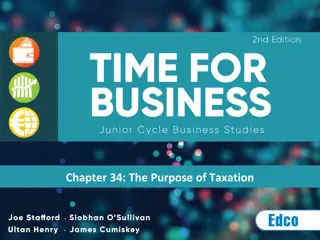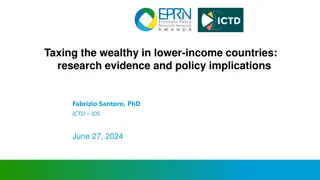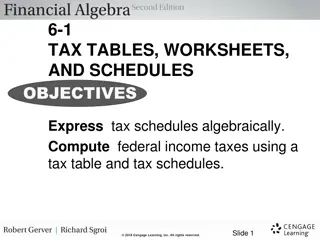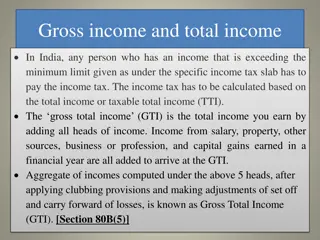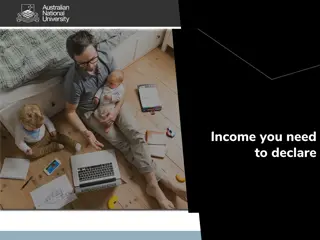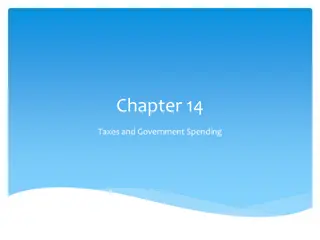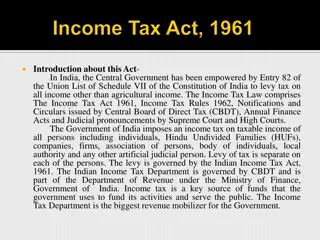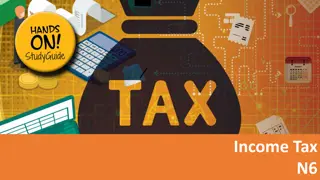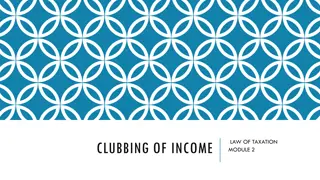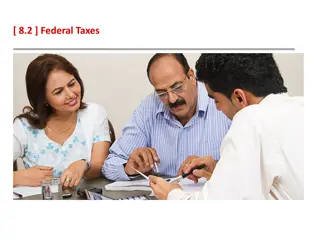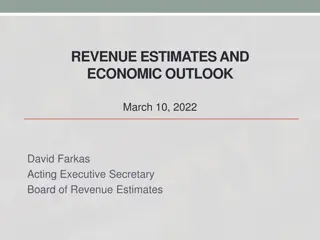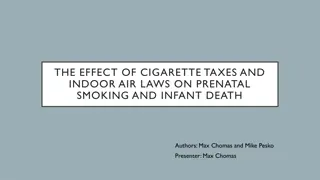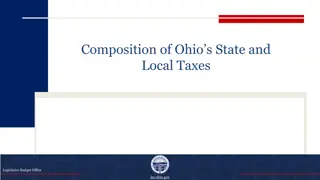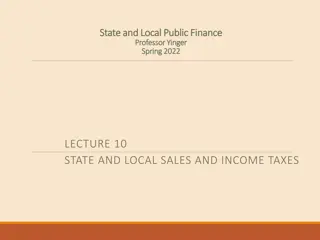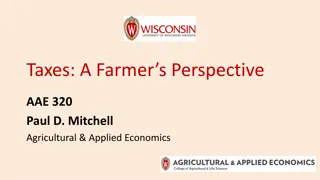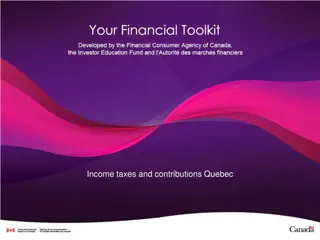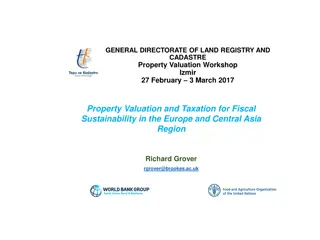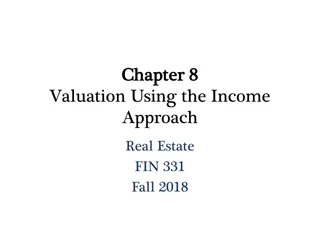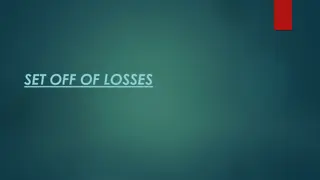Understanding Taxes and Income in India
Explore the concepts of taxes and income in India, including direct and indirect taxes, the Income Tax Act of 1961, government revenue, and the administration of income tax. Learn about the various components of income, tax laws, and the importance of proper tax administration for the country's financial health.
Download Presentation

Please find below an Image/Link to download the presentation.
The content on the website is provided AS IS for your information and personal use only. It may not be sold, licensed, or shared on other websites without obtaining consent from the author. Download presentation by click this link. If you encounter any issues during the download, it is possible that the publisher has removed the file from their server.
E N D
Presentation Transcript
Basic Concepts Basic Concepts Unit 1 Unit 1
Tax is a fee charged by a government on a product, income or activity. Tax is a fee charged by a government on a product, income or activity. There are two types of taxes . Direct taxes and indirect taxes. There are two types of taxes . Direct taxes and indirect taxes. If tax is levied directly on the income or wealth of a person, then it is a direct tax e.g. income If tax is levied directly on the income or wealth of a person, then it is a direct tax e.g. income- -tax, wealth tax. tax, wealth tax. If tax is levied on the price of a good or service, then it is called an indirect tax e.g. excise duty, Goods and Services Tax. In the case of indirect taxes, the person paying the tax passes on the incidence to another person. If tax is levied on the price of a good or service, then it is called an indirect tax e.g. excise duty, Goods and Services Tax. In the case of indirect taxes, the person paying the tax passes on the incidence to another person.
The they revenue Revenue meeting government of infrastructure dams The reason they constitute revenue to Revenue so meeting government like of infrastructure facilities dams etc reason for constitute the to the so raised levy of the basic the government raised is is utilised the like defence, education, facilities like etc. . of taxes basic source government. . utilised for the defence, provision education, for levy taxes is is that source of that of for of expenses expenses of provision health like roads, health- -care, roads, care,
Income The income following components. Income Tax Act, 1961 Annual Finance Acts Income Tax Rules, 1962 Circulars/Notifications Legal decisions of Courts Income- -tax is the most significant direct tax. The income- -tax law in India consists of the following components. Income Tax Act, 1961 tax is the most significant direct tax. tax law in India consists of the Annual Finance Acts Income Tax Rules, 1962 Circulars/Notifications Legal decisions of Courts
The levy of income Income The levy of income- -tax in India is governed by the Income- -tax Act, 1961. tax in India is governed by the tax Act, 1961. This Act came into force on 1st April, 1962. This Act came into force on 1st April, 1962. The Act contains 298 sections and XIV schedules. The Act contains 298 sections and XIV schedules. These undergo change every year with additions and deletions brought about by the Finance Act passed by Parliament. These undergo change every year with additions and deletions brought about by the Finance Act passed by Parliament. In pursuance of the power given by the Income rules have been framed to facilitate proper administration of the Income In pursuance of the power given by the Income- -tax Act, rules have been framed to facilitate proper administration of the Income- -tax Act. tax Act, tax Act.
Every year, the Finance Minister of the Government of India presents the Budget to the Parliament. Every year, the Finance Minister of the Government of India presents the Budget to the Parliament. Part A of the budget speech contains the proposed policies of the Government in fiscal areas. Part A of the budget speech contains the proposed policies of the Government in fiscal areas. Part B of the budget speech contains the detailed tax proposals. Part B of the budget speech contains the detailed tax proposals. In order to implement the above proposals, the Finance Bill is introduced in the Parliament. In order to implement the above proposals, the Finance Bill is introduced in the Parliament. Once the Finance Bill is approved by the Parliament and gets the assent of the President, it becomes the Finance Act. Once the Finance Bill is approved by the Parliament and gets the assent of the President, it becomes the Finance Act.
The administration of direct taxes is looked after by the Central Board of Direct Taxes (CBDT). The administration of direct taxes is looked after by the Central Board of Direct Taxes (CBDT). The CBDT is empowered to make rules for carrying out the purposes of the Act. The CBDT is empowered to make rules for carrying out the purposes of the Act. For the proper administration of the Income Act, the CBDT frames rules from time to time. These rules are collectively called Income Rules, 1962. It is important to keep in mind that along with the Income also be studied. For the proper administration of the Income- -tax Act, the CBDT frames rules from time to time. These rules are collectively called Income- -tax Rules, 1962. It is important to keep in mind that along with the Income- -tax Act, these rules should also be studied. tax tax tax Act, these rules should
Circulars are issued by the Central Board Direct Taxes (CBDT) from time to time to deal with certain specific problems and to clarify doubts regarding the scope and meaning of the provisions. Circulars are issued by the Central Board Direct Taxes (CBDT) from time to time to deal with certain specific problems and to clarify doubts regarding the scope and meaning of the provisions. These circulars are issued for the guidance of the officers and/or assessees. These circulars are issued for the guidance of the officers and/or assessees. The department is bound by the circulars. While such circulars are not binding the assessees they can take advantage of beneficial circulars. The department is bound by the circulars. While such circulars are not binding the assessees they can take advantage of beneficial circulars.
The study of case laws is an important and unavoidable part of the study of income The study of case laws is an important and unavoidable part of the study of income- -tax law. tax law. It is not possible for Parliament to conceive and provide for all possible issues that may arise in the implementation of any Act. Hence the judiciary will hear the disputes between the assessees and the department and give decisions on various issues. It is not possible for Parliament to conceive and provide for all possible issues that may arise in the implementation of any Act. Hence the judiciary will hear the disputes between the assessees and the department and give decisions on various issues. The Supreme Court is the Apex Court of the country and the law laid down by the Supreme Court is the law of the land. The Supreme Court is the Apex Court of the country and the law laid down by the Supreme Court is the law of the land. The decisions given by various High Courts will apply in the respective states in which such High Courts have jurisdiction. The decisions given by various High Courts will apply in the respective states in which such High Courts have jurisdiction.
Income previous year of every person. A person includes An individual, Hindu Undivided Family (HUF), Association of Persons (AOP), Body of Individuals (BOI), A firm, A company, Artificial Juridical Persons. Income- -tax is a tax levied on the total income of the previous year of every person. A person includes tax is a tax levied on the total income of the An individual, Hindu Undivided Family (HUF), Association of Persons (AOP), Body of Individuals (BOI), A firm, A company, Artificial Juridical Persons.
Income has to be computed as per the provisions contained in the Income Act, 1961. Let us go step by step to understand the procedure of computation of total income for the purpose of levy of income Income- -tax is levied on an assessee s total income. Such total income has to be computed as per the provisions contained in the Income- -tax Act, 1961. Let us go step by step to understand the procedure of computation of total income for the purpose of levy of income- -tax. tax is levied on an assessee s total income. Such total income tax tax. Step 1 Determination of residential status Step 2 Classification of income under different heads Step 3 Exclusion of income not chargeable to tax Step 4 Computation of income under each head Step 5 Clubbing of income of spouse, minor child etc. Step 6 Set Step 7 Computation of Gross Total Income. Step 8 Deductions from Gross Total Income Step 9 Total income Step 10 Application of the rates of tax on the total income Step 11 Surcharge Step 12 Education cess and secondary and higher education cess Step 13 Advance tax and tax deducted at source Step 1 Determination of residential status Step 2 Classification of income under different heads Step 3 Exclusion of income not chargeable to tax Step 4 Computation of income under each head Step 5 Clubbing of income of spouse, minor child etc. Step 6 Set- -off or carry forward and set Step 7 Computation of Gross Total Income. Step 8 Deductions from Gross Total Income Step 9 Total income Step 10 Application of the rates of tax on the total income Step 11 Surcharge Step 12 Education cess and secondary and higher education cess Step 13 Advance tax and tax deducted at source off or carry forward and set- -off of losses off of losses


